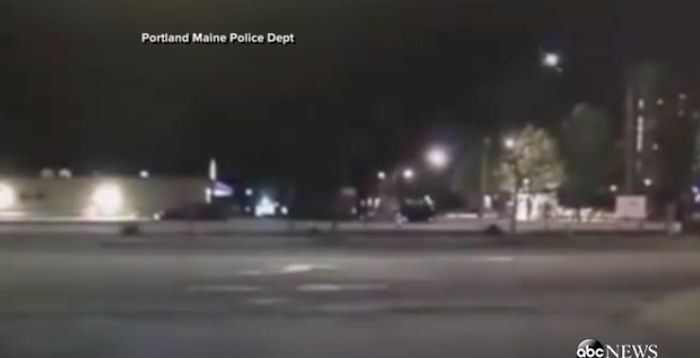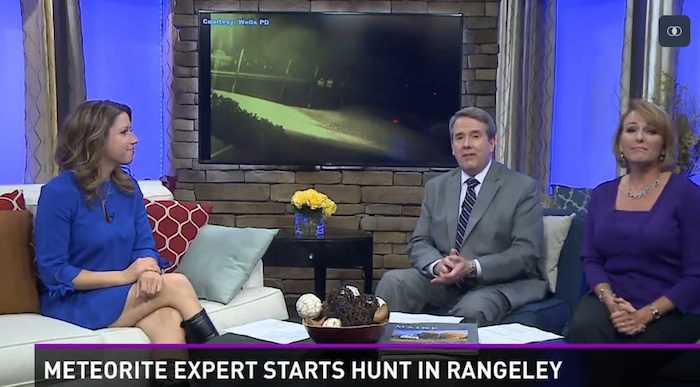.
17.05.2016
A large fireball lit up the sky shortly after midnight in the northeastern U.S. early Tuesday morning.
Police dashcam video from the Portland Police Department caught the fireball shooting across the sky in Maine.
The American Meteor Society says that it received 425 reports of the cosmic object, "seen primarily from Maine but witnesses from Vermont, New Hampshire, New Jersey, Massachusetts, New York, Rhode Island, Pennsylvania, Connecticut, Ontario (Canada) and Québec (Canada) also reported the event."
According to the AMS, "a fireball is another term for a very bright meteor, generally brighter than magnitude -4, which is about the same magnitude of the planet Venus as seen in the morning or evening sky."
The AMS says that while fireballs are very common occurrences, they are rarely seen.
.







Quelle: abc
-
Update: 18.05.2016
.
Watch: Meteor streaks through night sky over New England
-
A bright fireball streaked through the night sky over Portland, Maine, overnight, lighting up the darkness and startling those who saw it. CBS Portland affiliate WGME reports it happened just before 1 a.m. Tuesday. Several police officers caught the meteor on their dashcams and posted the videos online.
"The meteor (or alien spaceship) was caught on camera at approximately 0050 hours. Let's hope the visitors are friendly," the Portland Police Department wrote in a tongue-in-cheek Facebook post.
"As fireball observations go, this one was huge," the Maine Mineral and Gem Museum said in a press release announcing a $20,000 reward for the first person who finds and turns in a meteorite weighing at least one kilogram (2.2 pounds) for the museum to display.
"Based on hundreds of eyewitness accounts collated and analyzed by the American Meteor Society, it's clear that the meteoroid entered Earth's atmosphere over Maine and its terminal explosion occurred about 30 km west of Rangeley, Maine, in Franklin County," the museum wrote.
CBS Boston reports the meteor could be seen as far south as New Jersey and as far north as Nova Scotia. The American Meteor Society posted a stunning photo of it on Twitter, along with a map showing areas where viewers spotted the fireball.
.



Fotos: AMS
-
Quelle: CBS
-
Update: 25.05.2016
.
Meteorite Jagd in Rangeley lockt Experten aus Arizona






RANGELEY, Maine (NEWS CENTER) — Since a fireball was caught on camera last Tuesday morning, some people have descended upon the Rangeley area hoping to find a piece of the meteorite, and cash in on a reward being offered by the Maine Mineral and Gem Museum.
But now the search has stepped up a notch, attracting a planetary science field researcher from Arizona.
Robert Ward hunts for meteorites and has recovered fragments from all over the world. He offers pieces up to laboratories to study and learn more about our solar system; the rest he keeps in a private collection open to visitors.
"I think it's fascinating to touch something that came from outer space, it’s something that came from the solar system and I'm the first human to ever touch it."
Despite the dense woods and lakes surrounding the Rangeley region, Ward is optimistic he'll find something, especially after talking to a few of the locals.
"All of a sudden through the windows a flash of light came through," Brittanie Gragg remembers of Tuesday morning. "We kind of just got up wondering what was going on, it was really bright. Then we heard a rumbling that sounded like thunder."
Ward is focused a few miles into the woods, but much of the area he's hunting is on private property, so he's relying on the patience of landowners.
There is also a time crunch to find a fragment soon and get it into a lab for testing.
"Getting them into the lab as soon as possible is important and finding it as soon as possible is important," said Ward, "because as soon as it rains on these stones, the chemistry inside the stone will change."
Ward could use more witness help, so he's asking anyone who saw the fireball last Tuesday morning to file a report with the American Meteor Society.
.













Quelle: WCSH6
5500 Views
